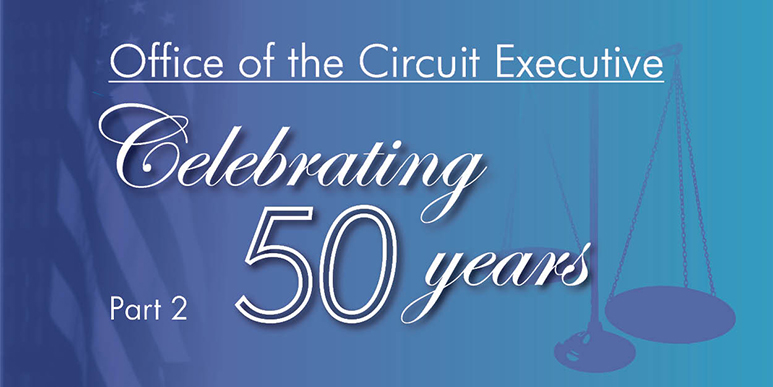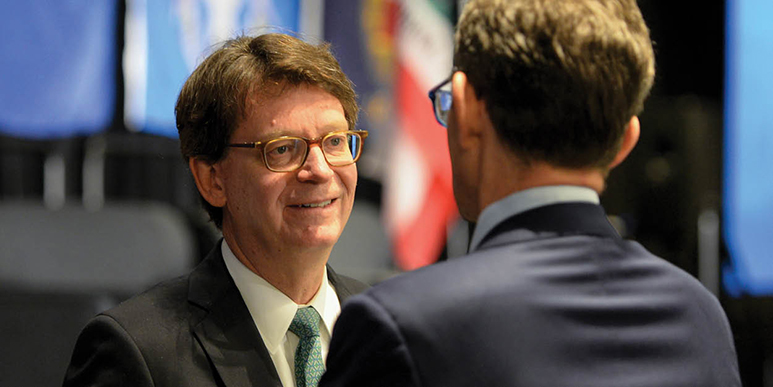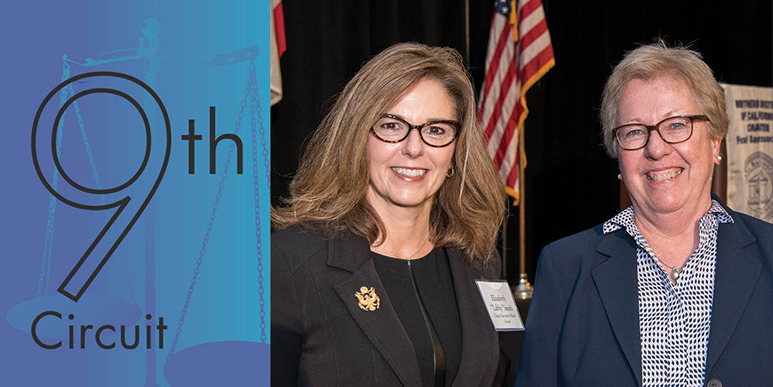
|
Circuit Executives Celebrate 50th Anniversary of Office - Part II
June 14, 2021 By William Cracraft
“Circuit executives are vital to the effective functioning of the courts. Our branch relies on their expertise and leadership in steering the federal courts on policy matters and the administration of court technology, fiscal and personnel management, court facilities, and court security. We are grateful for their active role in the administration of justice, their guidance to the AO, and their support of the Judicial Conference process.” –James C. Duff, former Director of the Administrative Office of the U.S. Courts. In 1971, Congress authorized each circuit judicial council to appoint a circuit executive to carry out the council’s directives in administering to the courts. This year, we celebrate 50 years of the Office of the Circuit Executive, the bedrock foundation that allows the courts to administer the law with a minimum of distractions. The 1971 legislation addressed, among other concerns, a caseload crisis in the federal courts and noted the judicial councils “shall take into account experience in administrative and executive positions, familiarity with court procedures, and special training,” when selecting court executive candidates. In 1985, 15 years after the circuit executive office was created, John W. Macy made a careful study of the circuit executive’s effectiveness, finding that although there were conflicts with entrenched methods of running a court and between clerks and court executives at times, circuit executives have filled “a decided need in the circuit courts,” that they “have undeniably contributed to the efficiency of the courts.” For more details on the founding of the Office of the Circuit Executive, see the first article in this series. Susan Goldberg has been circuit executive in the First Circuit since October 2014 and noted the most unique thing about the First Circuit is the cultural contrast between the four continental states in New England and the District of Puerto Rico. “A healthy trade route from Boston to San Juan contributed to Puerto Rico being included in the First Circuit,” said Goldberg. San Juan, Puerto Rico, is 2,700 miles from Boston. “The District of Puerto Rico also has a highly complex caseload, including a lot of gang prosecutions, violent crime and drug offenses but, like the other districts, it is an integral part of the First Circuit family and we have a wonderful relationship.” Goldberg and her staff of 25 handle new challenges almost daily. “They can range from interesting national developments in either Congress or the judiciary, to a strange press inquiry or request from a pro se litigant, to an amazing IT innovation, to dealing with earthquakes and hurricanes,” she said. “And presently, in dealing with the pandemic, there are literally hundreds of new and surprising developments every week. “I think that the circuit executive is the focal point for all of the court constituents in the circuit,” said Goldberg. “The job contains a very broad and wide-ranging set of responsibilities which require the circuit executive to serve as something of a hub for all information. Consequently, the circuit executive acts as more or less like a chief executive officer for all court of appeals judges and staff – managing budget, personnel, IT, space, security, public relations etc. – and works in close collaboration with every district and bankruptcy court in the circuit and with the Federal Defenders Offices … the AO, GSA, the US Marshals Service, the Federal Protective Service and with members of the public and press.” Cathy Catterson grew professionally as the circuit executive office matured. She started work at the Ninth Circuit as a deputy clerk in 1979, was appointed clerk in 1985 and, at age 33 and as a female, that was “kind of a big deal,” she said. “But I was a known quantity and, I’d like to think, had earned the respect of staff and judges.” She was appointed circuit and court of appeals executive in 2007, a spot she held until she retired in 2017, after almost 40 years in the judiciary. Catterson said the work of OCE is hidden to most judges and judiciary employees, “because those folks’ duties and functions revolve around the mission of the court – to decide cases. CE’s offices are a support function; to assist the courts in accomplishing that mission effectively. “I think those who are exposed directly to and get involved in circuit activities have a better understanding of the role of the CE’s office,” she said. The Ninth Circuit has suffered under emergency situations before. Catterson’s emergency was the 1989 Loma Prieta Earthquake in Northern California which “presented numerous challenges,” she said. “That was well before the time of electronic filing, though we did have an electronic docket at the time, thankfully, so at least we could try and track cases, somewhat.” Among her most memorable moments of that disaster was “watching the red tag being tacked on the front door of what is now the James R. Browning United States Courthouse. We were out of that building for seven years.” The ensuing challenges included “setting up a temporary courtroom in the Hastings Law School student resident building with the smell of washers and dryers permeating the air,” and “having our court offices split over six buildings in the Civic Center area, with my own office above Carl’s Junior for two years, and the file room in an old ballroom across the street where a large snake had made his home,” Catterson said. The building was fully retrofitted with state-of-the-art earthquake resistant features and re-opened in 1997. Dave Tighe has been circuit executive for the Tenth Circuit since January 2004 and has a staff of 25. He was deputy circuit executive for a little over two years and a staff attorney for nine years before that. “We are one of the most highly centralized circuits from an administration standpoint,” he said. “Everything is in my office except the mailroom, and that means budget and finance; HR; space and facilities; all IT including CM/ECF; event planning and support including judicial conferences; judicial council support; misconduct support, including actual investigations; case budgeting for both district and the circuit courts.” Tighe noted that despite the negative aspect, he finds misconduct investigations interesting. “Along with our own investigations, we’ve done several from other circuits because we have a pretty good reputation for handling them well,” he said. “I’m a good-government type, I have a background for this type of thing, and I don’t like the idea of people in power abusing that power. We’ve also done several disability investigations. Those are also interesting, but for different reasons. If a judge is having physical or mental health issues that are affecting his or her ability to do their jobs, it’s important to know that and help them in whatever way we can, with an eye toward the public’s view of the judiciary.” Tighe said one of the most fulfilling aspects of the job is “running an office that across the board is as good as any circuit executive’s office in the country. Because I like having responsibility and independence myself, I give that same responsibility and independence to my staff along with support when necessary. They all consistently step up, acting as professionals and as a team always willing to help each other. Right now, there are no weaknesses at any of our positions: no shirkers, no whiners. Just professionals who take their jobs seriously. That’s really nice and makes my job easy.” Elizabeth A. “Libby” Smith, circuit executive of the Ninth Circuit, has been in her role for four years. She holds a master’s degree in business information technology and was appointed circuit executive in early 2017, following an eight-year stint as clerk of court for the District of Idaho. Like most, if not all, circuit executives, Smith had deep experience in the courts prior to taking the circuit executive role. She assumed the clerk post in Idaho in 2009, served as the chief deputy clerk for the U.S. District Court for the Eastern District of Michigan from 2006 to 2009 and was the deputy court administrator for the Sixth Judicial Circuit Court from 1999 to 2006. Prior to that, Smith held administrative posts in both federal and state courts in her native Michigan. Smith’s contributions to the federal judiciary were recognized in 2016, when she was selected as one of three recipients of the Administrative Office of the U.S. Courts’ Director’s Award for Outstanding Leadership, the highest honor for judicial branch employees. All her experience made transiting to her current role easy. “It was extremely helpful having been with the Circuit as a district and bankruptcy clerk,” Smith said. “Having relationships with all of the chief district judges, chief bankruptcy judges and clerks, most of the probation and pretrial services chiefs, the chief circuit judge and others, sure helped me to hit the ground running.” The Ninth Circuit is the largest circuit geographically and in terms of the number of cases handled. One element of the Ninth Circuit stands out in comparison to other circuits. “The Ninth Circuit has four Outside the Continental United States (OCONUS) courts, two being territorial courts in a time zone which is 17 hours ahead,” said Smith. The circuit manages the Department of the Interior grant that funds the support and training of judges, justices, clerks of court and others within the Pacific Islands, said Smith. That district includes American Samoa, Guam, the Commonwealth of the Northern Mariana Islands and the former Trust Territories of the Federated States of Micronesia, the Republic of the Marshall Islands and the Republic of Palau. Palau is over 9,000 miles from the U.S. No other circuit oversees such distant judiciaries. Like all of her peers, Smith said the best part of her job is “all of the wonderful people I get to work with within the circuit, across the nation, and at the Administrative Office. That includes our stakeholders and partners in other agencies, the bar and others.” Smith manages one of, if not the biggest OCE staff in the country, with 44 employees. “Our staff support the nearly 500 judges, 61 courthouses and 43 other facilities, 39 chief judges at district level and over 60 court unit executives, within the circuit,” said Smith. “I sometimes refer to the relationships between the courts and the circuit as being ‘extended court family.’” The professionalism of individuals is critical to the whole. “Many of our staff have court or AO experience with the state or federal courts and/or specialized experience, e.g., architects, project managers, IT professionals, HR and finance professionals, lawyers, paralegals, trainers and others,” said Smith. “I describe our role as being “consultants” for the judges, CUEs and others within the Circuit.” “Through our conferences, committees, working groups, programs and training opportunities, judges and staff at all levels have an opportunity for their voice to be heard. A few of the disparate programs and committees that come to mind include the 2015 Corrections Summit, which brought federal and state corrections officers together for the first time; the Jury Trial Improvement Committee, the IT Committee, the Committee on Workplace Relations and the Ninth Circuit Fairness Committee.” Like her peers, Smith thrives on the complexity and variety of her responsibilities. “This is the most challenging and fulfilling position I will likely ever hold. I get to fulfill my personal credo which is to strive each day to be my best self, so that I might be of service to others,” she said. “That fulfillment comes from a combination of where I am in my professional career – hopefully at the top of my game, being able to serve in this executive role for an institution with such an incredible history, brilliant jurists, leaders and employees, and every day being presented with new challenges and opportunities. I am so very fortunate for infinite reasons,” Smith said.
|
||||






